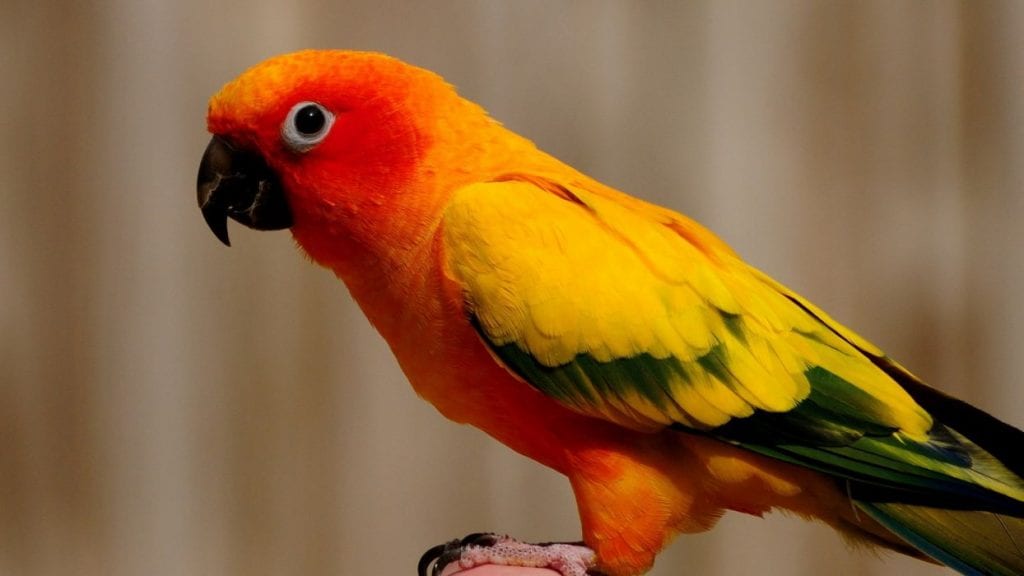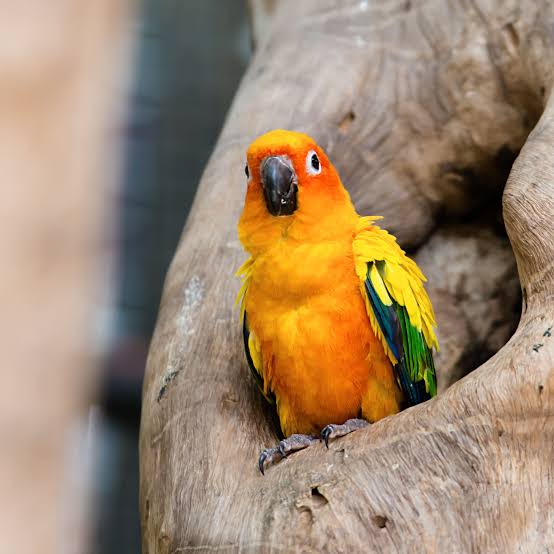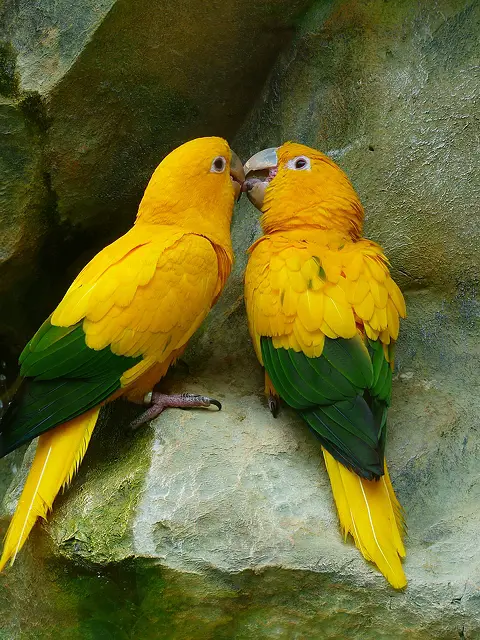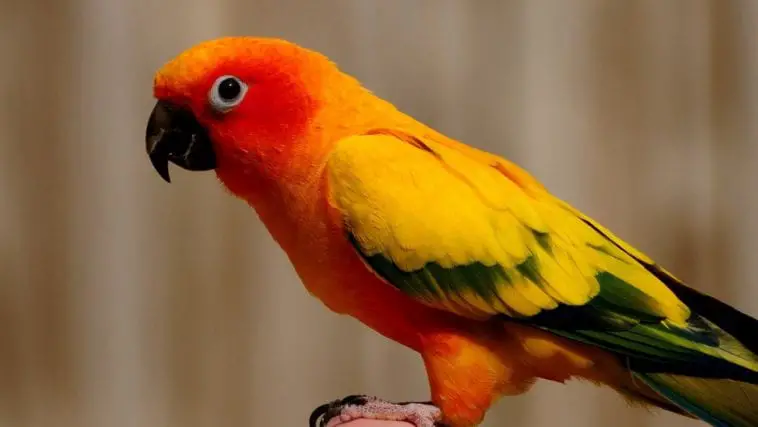Scientific Facts
| Common Name | Sun Conure |
| Scientific Name | Aratinga solstitialis |
| Origin | South America, specifically Venezuela, the north Brazilian state of Roraima, southern Guyana, extreme southern Suriname, and southern French Guiana. They also occur as vagrants to coastal French Guiana |
| Habitat | They are usually found in inland tropical habitats, dry savanna, coastal forests, and woodlands. They are usually seen on palm groves and fruiting trees. They are usually seen with an altitude of fewer than 1200 m or at the edge of a humid forest or in foothills and shrublands. |
| Diet | flowers, fruits, blossoms, seeds, nuts, and some small insects; strawberries, grapefruit, blackberries, raspberries, papaya, apples, bananas, oranges, beans, grass seeds, peas, nuts, cucumbers, gooseberries, currants, rose hips, tomatoes, cress, spinach, Chinese cabbage, roquette, chickweed, broccoli, carrots, dandelions, germinated sunflower seeds, mealworms and ant eggs. |
| Size and Weight | Size: 12 inches (30cm) in length up to the tails Weight: The average weight of an adult conure is about 3.5 – 4.5 oz (100 – 130g). |
| Lifespan | 15-30 years |
Physical Description

At maturity, the sun conure has an overall bright orange and yellow colors with splashes of blue and green. They have a black beak, white rings on their eyes, and a long tail. Their colors are described to have a sunny striking coloration. The sun conure only shows its vibrant color after two years or after it reaches its maturity. The juveniles do not have vibrant colors like that of adults as their defense mechanism. Their first feathers look olive green with a mixture of light yellowish-orange colors until they reach 6 months old. It is said that their full-color plumage will show up when they reach 1 year.
Both males and females do not have physical differences; that is why a way to know which one is a female or a male is through DNA sampling, but experts would suggest that the females have a rounder and smaller head while the males have a flatter and squarer head. The first feathers are olive green in color, changing to a mixture of yellowish-orange at around 6 months of age. Full-color plumage can be observed at approximately 1 year of age. The adult sun conure is characterized to have a rich yellow crown, nape, mantle with face and belly area that are colored orange and red up to their ears. All their flight feathers have dark grey color. The sun conure is also known as the sun parakeets.
Where it is Seen?
The sun conure is native to South America, specifically Venezuela, the north Brazilian state of Roraima, southern Guyana, extreme southern Suriname, and southern French Guiana. They also occur as vagrants to coastal French Guiana. Populations found along the Amazon River in Brazil are now known to belong to the sulfur-breasted parakeet.Their status in Venezuela is unclear, but recent sightings from the southeast near Santa Elena de Uairén have been reported. They may occur in Amapá or far northern Pará (regions where the avifauna generally is very poorly documented due to their populations), but this remains to be confirmed. Populations found along the Amazon River in Brazil are now known to belong to the sulfur-breasted parakeet.
Habitat

They are usually found in inland tropical habitats, dry savanna, coastal forests, and woodlands. They are usually seen on palm groves and fruiting trees. They are usually seen with an altitude of about 1200 m or at the edge of a humid forest or in foothills and shrublands.
Behavior and Temperament

The sun conure is an amusing bird that enjoys doing different kinds of activities, whether in the wild or in captivity. They are extremely loud through their ear-piercing screams, but in the wild, this screams serves as a call to communicate with other birds that are miles away; that is why when they are taken in captivity, their noise is quite disturbing. These types of conures are showy, especially if their needs are not met, you would know that they need something if they start to be noisy.
They usually stay in flocks with about 20 to 30 individuals. If it so happens that they get separated, they’ll scream and squawk in a very high-pitched voice so that other birds will be alerted. They can travel miles away in a single day to look for food and nest. They have the ability to use their feet like hands to eat and do some other things. They are naturally smart; that is why they need constant social interaction and mental stimulation.
Breeding and Reproduction
When the sun conures are about 4 to 5 months of age, they form monogamous pairs to feed and groom one another before the breeding season takes place. After the pair becomes affectionate and comfortable with each other, they mate for about three minutes. The fertility of the sun conures has a high success rate. The female’s abdomen will be swollen, a clear indication that she will lay eggs soon. They will start to nest in tree cavities, usually in Maurita flexuosa palms. The females may lay about three to four white eggs, which will be laid in about two to three-day intervals.
If, in any case, the eggs will come out destroyed due to calcium deficiency, they will just eat it. The females only incubate the eggs for about 23 to 27 days while the male’s responsibility to look for food, and they will aggressively protect the nest from predators. The incubation process is very important because if there is no heat, the eggs will break and it will fail to hatch.
The juveniles are born naked, blind, and vulnerable. It would take 10 days for them to open their eyes and starts to develop feather quills. At this time, both parents will feed their young for about 7 to 8 weeks or until they become independent after 9 to 12 weeks. The sun conures reproduce old enough at the age of two, and they lose their fertility when they reach the age of 9 or 10 years.
Diet
The sun conures feed on a wide variety of foods that they can see in the wild such as flowers, fruits, blossoms, seeds, nuts, and some small insects. They eat both ripe and half-ripe berries and other fruits. If it so happens that they landed in an agricultural setting, they feed on agricultural crops, making them pests. There are certain nutrients intake their body needs on different occasions such as lots of protein intake during the breeding season, more on carbohydrates when they feed on their young, and sufficient calcium intake for egg production.
In captivity, these are the list of fresh fruits and vegetables that you can feed them strawberries, grapefruit, blackberries, raspberries, papaya, apples, bananas, oranges, beans, grass seeds, peas, nuts, cucumbers, gooseberries, currants, rose hips, tomatoes, cress, spinach, Chinese cabbage, roquette, chickweed, broccoli, carrots, dandelions, and germinated sunflower seeds. These are also the insects that they feed upon, mealworms, and ant eggs. Cuttle bones, mineral blocks, and gravel or ground oyster shells may be given to them that consist of additional vitamins, nutrients and it aids indigestion.
Size and Weight
On average, the sun conures measures around 12 inches (30cm) in length up to the tails. The average weight of an adult conure is about 3.5 – 4.5 oz (100 – 130g). It is important to always maintain the weight of sun conures and make sure it doesn’t exceed the expected weight to avoid health problems and to make sure that they will stay fit and active.
Lifespan
A sun conure can live between 15 to 30 years as long as it receives proper nutrition, exercises, and regular veterinary visits. Their lifespan in captivity is higher than the wild because of so many factors. In the wild, the sun conures fight for their lives because of the destruction of their habitat due to illegal hunters and shortage and competition for food; that is why it is no surprise that this good-looking conure species are already threatened. In captivity, they can maximize their lifespan expectancy as long as you would give them an ideal environment plus care and attention.
Common Diseases/Illnesses
1) Abnormal droppings
One of the signs that your sun conure has health issues is if it has abnormal droppings, may it be through the color, consistency, and texture. The first thing in mind if they have an abnormal dropping is that maybe the food that was given to them just irritated their digestive system, but in some cases, there is a possibility that it could mean something else. If it so happens that you had changed their diet a couple of days or hours before they had an abnormal dropping, there is a possibility that it is just because of the sudden change of food intake and usually, their body will just get used to it, and their droppings will eventually return to normal.
These are some of the possible reasons why birds have abnormal droppings if it is not related to their diet, liver disease, kidney disease, and bacterial infection. It is important to always seek help from your veterinarian especially if the abnormal droppings last for days to see possible cause and cure
2) Scratching and Feather plucking
When your bird scratches and plucks its feathers, it could mean that they are experiencing irritabilities due to parasite infestations or due to internal disorder or worse, they have already developed a bad habit. When it is due to parasite infestation, they feel that their body is itchy, that is why they scratch their feathers until they reach their skin. If it is due to an internal disorder, there is a possibility that the way for them to ease the pain is by means of scratching their bodies.
Experts said that when there is no problem with their hygiene and if they are physically fit, there is a possibility that they do these actions is because they have already developed a bad habit just to get attention from their owners, especially when they are bored, frustrated and stressed. As soon as you see these actions from your bird, take them immediately to a veterinarian to see that possible cause because if the underlying problem is not addressed, it could affect the overall appearance of the bird and it could also lead to other skin infections and other illnesses because of the pain that they inflict into their bodies.
3) Obesity
As soon as the bird is taken into captivity, there are high chances that they’ll become overweight or obese due to limited physical activity. Like humans, obesity and overweight for birds are linked to other health conditions such as the development of benign fatty tumors and lipomas or a layer of fat on the surface under the skin usually found on their abdomen, chest and thigh part that will really affect the way they move and do things. Since the mass of fatty areas found on the different parts of their body affects how they do things, it is needed to remove the deposited fats through surgery, and the surgical procedure is quite dangerous and could be fatal.
The obvious signs that they are already overweight or obese are when they look larger compared to a normal-sized sun conure that makes their joints and bones stressed, and they will also have difficulty breathing. It will not only restrain them from doing different things, but the rapid change in their body could also lead to different kinds of illnesses such as pancreatic disease, liver disease, and diabetes. The best way to attend to overweight and obesity issues is to start with their diet, make sure to only give them nutritional foods that are enriched with vitamins and minerals and is free from fats and sugar.
4) Avian Gastric Yeast
When your bird is infested with both yeast and bacterial infection, except that it will specifically target their digestive system’s functioning wherein their body will have difficulty in digesting food for nutrient uptake. It is quite hard to detect of your bird is suffering from this disease because of the immediate effect of weight loss due to malnutrition. The only sign that will give you a hint that this bird is suffering from this disease is when their droppings consist of undigested food. They would also vomit undigested food as well a few minutes or hours before they have eaten. The only way for the bacteria and yeast to be cured is through antibiotics intake so that the good cells that were damaged would be replaced. Your veterinarian will give you the right medications to effectively manage the disease.
5) Salmonella
This disease is both contagious to birds and humans. It is caused by bacteria that targets the intestinal tract that causes intestinal-tract infection. The infected bird would also have diarrhea and ruffled feathers. As soon as you see these symptoms, take your bird to a veterinarian because usually, this disease can kill them for about 3 days only. If you place more than 1 bird in a cage, remove the infected ones because this disease can spread rapidly. Salmonella is also transmittable to humans, so be sure to wear protective gear.
6) Mycobacterial Disease
Mycobacterium is one of the most common respiratory illnesses of a sun conure, may it be a wild-raised or a captive-raised. This happens when your bird is exposed to too cold or too warm temperatures; that is why you should always place them in an ideal environment. If you are living in too warm or too cold temperatures, it is best to invest in a warmer or cooler, so the room temperature is always achieved. When your bird is infected with this disease, their white blood cells should be increased. This disease is fatal if not attended to properly
7) Egg Binding and Dystocia
The egg binding and dystocia are described as difficulties laying eggs. It is a serious condition experienced by almost all females under parrot species where the egg can’t pass through to the oviduct; thus, the egg is stuck, and it is fatal if the bird won’t be able to release it. On the other hand, dystocia is a serious presentation of egg binding because the cloacal functioning is obstructed; that is why the eggs can’t pass through.
The main cause of these diseases is due to a malfunction of the bird’s reproductive organs. When your bird is having some problems laying eggs, there are high chances that it is due to Vitamin D and calcium deficiency, so injecting the bird with these nutrients will be helpful. Aside from egg binding and dystocia, there is also a high chance that the eggs will appear malformed and soft-shelled.
8) Gout
Gout is a result of unhealthy habits of birds may it be in their food intake or in their physical activities. Gout is characterized as-deposited urate into the bird’s joints and even to different surfaces of their organs such as the heart, liver, and nephrons. When the gout is deposited into their joints, it causes pain, especially when they walk, hops, stand or even fly, but when gout is on their organs, it could lead to other diseases such as heart ailments, liver, and kidney diseases which is fatal if not attended to properly. The medications colchicine and allopurinol are commonly used by humans when they have gout, in veterinarians, they also use these types of medications to cure the gout of birds.
Preventing Illnesses
The sun conure has a strong immunity as long as the conditions are right. In captivity, different factors such as the housing, temperature, substrate, accessories, and handling should be taken into consideration to ensure that the parrot will live happily and healthily. There is no perfect environment for parrots, but there is an optimal condition where they can live longer. The different diseases or illnesses that infest them is a big factor that affects their lifespan. You need to observe thoroughly that the energy of the parrot is consistent every day, if there is a detrimental change in how they behave, it means that there is something wrong that is why you need to be more attentive on how to deal with their concerns.
One of the causes, why different species of conures are infested with diseases and illnesses caused by bacteria and fungi is due to unsanitary housing. It is not only important to clean their housing, but you also need to clean all the things that it’s in there, such as their substrate, toys, water, and food bowl. You need to make sure that the cleaning agent that you will be used in cleaning their cage is safe for them because if you would use household cleaning agents, it may harm the health of your bird because it is too toxic for them due to the harmful chemicals it contains.
When it comes to feeding them, make sure to consult with your veterinarian because there are the right types of pellets or foods that are only applicable to them. Always make sure that the food that you will give them is always fresh. If there are any leftovers, do not let them eat it again. Having regular check-ups will also help your bird to be healthy to detect even the simplest illness that may turn into a serious disease when not attended to earlier.
Captive Breeding
The sun conures are a popular option as a captive pet because of their vibrant color and their superb intelligence. It has a small size, but it has a very loud squawk, so make sure that before taking them, no one in your place is sensitive to their noise. Another thing to consider before deciding to take them in captivity is their inquisitive temperaments that require a great deal of attention from humans, especially their owners.
They are charming, affectionate, and friendly to people with whom they are familiar but expect that they can be aggressive to those whom they are not familiar with since they are also territorial. They are a hardy species of conure as long as they stay in an ideal environment like that of their natural habitat. The sun conures are already listed as an endangered species; that is why captive breeding is encouraged to somehow take good care of their remaining population.
Availability-Where to Get One?
The sun conure is already tagged under endangered species; that is why there is strict monitoring of their population in the wild, but there are personal bird breeders that have sun conures that are being sold for quite a high price, you may search for them on the internet. Purchasing from a certified bird breeder will surely give you a sun conure that is really bred for captivity. In some places, you may need to have a permit to avail one
How to Care Parrot as a Pet?
Housing
The sun conure is an active bird that enjoys doing a lot of activities; that is why they should be confined in a roomy enclosure that has at least dimensions of 20 by 20 inches with a height of 36 inches. The cage should have at least 3/4 to one-inch bar spacing because if the bar spaces are quite wide, there is a possibility that the bird’s head will be stuck when they peep out. Place the cage in a place where they can have plenty of human interaction so as to avoid boredom and neglect. They do well in average household temperature. Make sure that it does not go down beyond 65 degrees Fahrenheit and does not exceed 80 degrees Fahrenheit. Choose a cage that has a metal grate with a tray so that they won’t step on their droppings.
Accessories
If you trained your bird to do some tricks, you might need to have a play gym set up so that they can further enhance it. They sleep and spend their free hours in a perch that is why it is advisable to have at least 2-4 perches depending on the size of the cage. Place one perch at the top part of the cage because it is where they usually sleep. The different kinds of toys that they can play with will further enhance the intelligence that they have, and it will also keep them busy to avoid boredom.
Feeding
In captivity, they feast on a balanced diet that consists of pelleted mixes and fresh fruits and vegetables. They also appreciate treats, but you also need to give them healthy options. An example of healthy treats are seeds, walnuts, almonds, and you may also give them fruits. The pelleted mixes make up 60 to 70% of their diet; that is why you need to make sure that it is enriched with vitamins and nutrients to avoid nutrient deficiency.
Fresh foods should always be available together with clean water in a separate bowl. There are foods that shouldn’t be given to them, such as avocados, chocolate, caffeine products, and alcohol, as well as sugary and fatty foods.
Exercise
Exercise also plays an important role in birds to avoid different kinds of illnesses related to being overweight and obese. They are, by nature, active, and love exploring things so as long as their bodies are always moving like flying, hopping, and playing that will serve as their exercise. You should also have time for your pet several hours a day out of the cage when you plan to train them. Through exercise, not only that their bodies benefit from it, but their overall mental and emotional aspects benefit from it because when they exercise, they form a special bond with you to avoid behavioral problems link with boredom, frustration, and stress.
Conservation Status
The sun conures are now listed as an endangered species by the IUCN red list due to a couple of reasons such as loss of habitat and illegal hunting for pet trades. Research shows that at least 800,000 of their populations are being trapped each year. Captive breeding and other activities of increasing their population, whether in the wild or in captivity is encouraged.
Fun Facts About Sun Conure
- There are only a few of their populations in the wild; that is why there is only a little information about the lifestyle of the sun conures.
- They usually stay in a flock in the wild during their feeding sessions, but they are not actually considered as a social bird because, in the wild, they do better alone, especially escaping from their predators.
- The sun conures do not only stay in their nest during the breeding season only, but they spend most of their time on these nest to rest and also serve as their habitat.
- They are known to be a clown-like because of their playful and active personality.
- Their sharp screeching calls make them often mistaken as little macaws.
- The sun conures sleep at around 10-12 hours from the moment the sun goes down until the sun comes up again.
- The sun conures are not fond of bathing just like other conure species, but if their water bowl is big enough, expect that they will soak their bodies as a form of a play.
FAQ Section
Can a sun conure talk?
The sun conures are not that good talkers, but with great patience and effort, they may practice their speaking skills that can utter 10-15 simple words but not as seamless as other conure species.
Is the sun conure expensive?
Acquiring a sun conure is expensive, especially if this is your first bird pet. Its price may range up to $400-500 dollars depending on the maturity of the bird. It is more expensive to buy an adult sun conure than a juvenile. Their pricing also depends on their population status, which is now in a threatened status.
Are sun conures good for beginners?
The sun conures are not recommended for beginners because it requires special care and maintenance, but if you give them what they need, they are a hardy type of conure species that are playful and affectionate.
How smart your sun conure is?
The sun conure as an intelligent bird that can be trained with different words and tricks. They are a good companion bird because they have the ability to acknowledge their owners and form a good bond with them.
Do sun conures like to cuddle?
These conure species have the ability to be affectionate to humans, especially with their owners. They need your attention; if they are not satisfied with the attention that you will give them, there is a tendency that they can develop behavioral problems.
Do sun conures bob their heads?
The sun conures also bob their heads, and this is normal. During the breeding season, it is done by male sun conures as part of their courtship dance. This is the bodily gesture that they show off to let the females know that they want to mate. The bobbing of their heads is characterized by moving their heads up and down while climbing at the highest point of their cage while banging their beaks back and forth.
Are sun conures really that loud?
The sun conures are included on the list of conure species that are loud. They scream on some occasions within the day to express their happiness, excitement, anger, frustration, and boredom. Sometimes, their scream is an alarm that your bird needs something else.
Are sun conures aggressive?
The sun conures are still considered as a wild animal that is why they are naturally an aggressive animal. Their aggressiveness is linked to their biting capability, so training is important to somehow tame them.
Do sun conures do better in pairs?
The sun conures love to stay in a flock in the wild; that is why in captivity, it is also advisable to have them in pairs. However, if you started out to take good care of them in pairs, be wary that once they are left alone, it is more likely that they will be susceptible to different kinds of sickness and depression.
Should you cover your sun conure’s cage at night?
It is not necessary to cover your conure’s cage at night but make sure that the place where they are is quiet and dark. Some owners take their place in a secluded area at night so as not to disturb the bird’s sleep. However, if you feel that your bird will not have a peaceful sleep, cover it during the sleeping hours and don’t forget to uncover it at day time.
Can you train a sun conure to stop screaming and just to be quiet?
The sun conure is naturally a loud bird; that is why they will never be quiet, but their noise and screams can still be managed through proper training.
How long do sun conures sleep?
The sun conures sleep for about 10-12 hours, longer than the average sleep of a human to keep them healthy and fit, rest is important for them, so make sure that their cage has a resting area such as perches situated on top of the cage.



